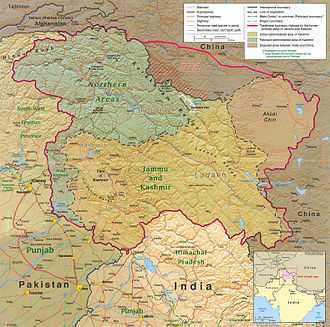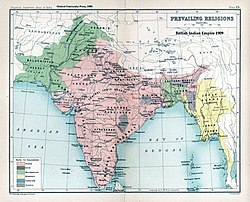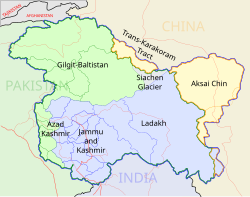Kashmir
Kashmir, previously spelled Cashmere, is a region in South-central Asia. Historically, the name Kashmir referred to the valley just to the south of the western end of the Himalayan mountain range. Today, Kashmir refers to a much larger area that includes the Indian state of Jammu and Kashmir (which includes the Kashmir Valley, Jammu region and Ladakh), Azad Kashmir and Gilgit–Baltistan (part of Pakistan), and Aksai Chin and the Trans-Karakoram Tract (part of China). The main "Valley of Kashmir" is a low-fertile area surrounded by mountains and contains many rivers. People like it for its natural beauty and simple lifestyle. The region is part of a border dispute between India and Pakistan.
In total it has an area of 230,166.1 square kilometres or (89,106 square miles). The population of the region is more than the individual populations of 127 UN member nations and its area is larger than that of 97 nations.
Etymology of Kashmir
The name of the land is thought to be derived from the process of desiccation - Ka means "water" and Shimir means "to desiccate". Hence, Kashmir stands for "a land desiccated from water". There is also a theory which takes Kashmir to be a contraction of Kashyap-mira or Kashyapmir or Kashyapmeru, the "Sea or Mountain of Kashyapa", the sage who is credited with having drained the waters of the primordial Lake Satisar, that Kashmir was before it was reclaimed. The Nilamata Purana gives the name Kashmira to the Mira" which means the sea lake or the mountain of Sage Kashyapa. Mira in Sanskrit means Ocean or boundary, considering it to be an embodiment of Uma. The Kashmiris, however, call it Kashir, which has been derived phonetically from Kashmir.
The Ancient Greeks called it as Kasperia. Kashyapa-pura, which has been identified with Kaspapyros of Hecataeus (apud Stephanus of Byzantium) and Kaspatyros of Herodotus (3.102, 4.44); In classical literature Herodotus also called it Kaspatyrol.[1] Kashmir is also believed to be the country meant by Ptolemy's Kaspeiria. Xuanzang, the Chinese monk who visited Kashmir in 631 AD called it Kia-shi-mi-lo, the Tibetans called it Khachal, meaning "snowy mountain".[1] It is and has been a land of rivers, lakes and wildflowers. Cashmere is an archaic spelling of present-Kashmir, and in some countries it is still spelled this way. A tribe of Semitic origin, named Kash (which means a deep slash in the native dialect), is believed to have founded the cities of Kashan and Kashgar, not to be confused with the Kashyapi tribe from Caspian. The land and the people were known as 'Kashir' from which 'Kashmir' was also derived.
History
The Kashmir conflict has existed since India and Pakistan became independent states. At first, the Maharaja of Jammu and Kashmir, Hari Singh, wanted his state to remain independent of both India and Pakistan. On 20 October 1947, tribesmen supported by Pakistan invaded Kashmir. Singh fought back at first, but on 27 October, he asked the Governor-General of India, Louis Mountbatten, for help. He agreed, but made Singh turn over Jammu and Kashmir to India. Once the papers of accession to India were signed, Indian soldiers entered Kashmir with orders to stop any further occupation, but they were not allowed to expel anyone from the state. Pakistan claimed that it was illegal for Singh to give Kashmir to India, and the First Kashmir War was started. India took the matter to the United Nations. The UN resolution asked Pakistan to vacate the areas it had occupied and asked India to assist the U.N. Plebiscite Commission to organize a plebiscite to determine the will of the people. Pakistan refused to leave the occupied areas.
In 1953, as the US-Pakistan Mutual Defence Pact was being formed, Nehru declared an ultimatum. Pakistan would have to choose between a plebiscite with the possibility of winning control over Kashmir, or their pact with the US. As the alliance formed and was concluded in 1954, Nehru withdrew the offer of plebiscite. Kashmir remains an area of conflict until today.[2]
Lines of control
India and Pakistan have fought several wars over Kashmir. In 1949 and 1972 they agreed on a border for most of the Territories (except for the Siachen Glacier). This demarcation line which marks the border between India and Pakistan is known as the Line of Control. It is guarded by Indian and Pakistani troops.
The border between Aksai Chin (held by China) and Jammu and Kashmir (held by India) is known as Line of Actual Control.
The Kashmir border between the Punjab (Pakistan) and Indian-administered Kashmir is called the working boundary, but is not recognised by Pakistan. India has built a fence along part of this border.
The Siachen Glacier and the bordering Saltoro Range first saw military action in 1984 when the Indian Army occupied the glacier and the Saltoro range to prevent Pakistan from occupying the area. This operation was codenamed Operation Meghdoot. There have been several minor changes to the held positions. However, the Indian Armed forces have held onto the heights on the plateau, preventing Pakistani soldiers from climbing up the Saltoro range.
The Actual Ground Position Line (AGPL) refers to the current position that divides Indian and Pakistani troops in the Siachen Glacier region. The line extends from the northernmost point of the LOC (Line of Control) to Indira Col. This line runs across the edge of the Saltoro Range, which is a mountainous plateau with peaks that are over 8,000 meters tall. The current position of the AGPL follows the general line:
Indira Col - Sia La pass - Saltoro Kangri 1 - Bilafond La pass - K12 - Gyong La pass - NJ9842[3]
Administrative divisions
Today Kashmir is split, as follows:
- The Republic of India controls the state of Jammu and Kashmir. It is made of the Jammu region, the Kashmir Valley, and Ladakh. Pakistan refers to this as Indian-occupied Kashmir, Indian-controlled Kashmir, Indian-annexed Kashmir, or Indian-held Kashmir.
- The territories known as Northern Areas and Azad Jammu and Kashmir are administered by Pakistan. The government of Pakistan calls them Pakistan-administered Kashmir. The Republic of India refers to this as Pakistan-occupied Kashmir.
- The region called Aksai Chin is controlled by China.
- The Trans-Karakoram Tract is an area Pakistan gave to China on 3 March 1963. Pakistan says the area was uninhabited, so there is no problem to this. India claims the swap was illegal and that the area is part of its state Jammu and Kashmir.
- The Siachen Glacier is currently a disputed territory. India controls the glacier, and Pakistan controls the valley below.
The Disputed territory of Kashmir is divided into five administrative Divisions, namely:
A group of Districts forms a Division, which is administered by a 'Divisional Commissioner'. Kashmir is now divided in twenty-one districts, grouped under five divisions jointly controlled by Pakistan and India respectively:
| Baltistan | Gilgit | Jammu | Kashmir | Ladakh |
|---|---|---|---|---|
|
|
|
Economy

Kashmir's economy is centred around agriculture, like that of Pakistan. Traditionally the staple crop of the valley was rice, which formed the chief food of the people. In addition, corn, wheat, barley and oats were also grown. Given its temperate climate, it is suited for crops like Asparagus, Artichoke, seakale, broad beans, scarlet runners, beetroot, cauliflower and cabbage. Fruit trees are common in the valley, and the cultivated orchards yield pears, apples, peaches, and cherries. The chief trees are deodar (National tree of Pakistan), firs and Pines, chenar (State tree) or plane, Maple, birch and Walnut, apple, cherry.
Historically, Kashmir became known worldwide when Cashmere wool was exported to other regions and nations (exports have ceased due to decreased numbers of the cashmere goat and increased competition from Western China). Kashmiris are good at knitting and making Pashmina Shawls, silk carpets, rugs, Kurtas, and Pottery. Saffron, too, is grown in Kashmir. Efforts are on to export the naturally grown fruits and vegetables as organic foods mainly to the Greater Middle East region which it forms an integral part. Srinagar is known for its silver-work, papier mache, wood-carving, and the weaving of silk.
The economy was badly damaged by the 2005 Pakistan earthquake which, as of 8 October 2005, resulted in over 70,000 deaths in the Pakistan-controlled part of Kashmir and around 1,500 deaths in Indian controlled kashmir.
The Indian-held portion of Kashmir is believed to have potentially rich rocks containing hydrocarbon reserves.[4][5]
Tourism
Tourism has been important in Kashmir for many years. Many people call the region Paradise on Earth.[6] Tourists from all over the world visit Kashmir. In the 21st century, fewer people have visited Kashmir because of terrorism. Kashmir is regularly referred to as Jannat-e-Kashmir due to its connotation with paradise. The term Jannat-e-Kashmir is originally a Persian phrase referring to Kashmir because of the many Persian Sufi saints who visited the Kashmir Valley and wrote poems about it in Persian language. Many Sufi saints are buried in the Kashmir Valley and there are Sufi shrines everywhere in Kashmir.
Religion
| Religions in the Kashmir region | ||||
|---|---|---|---|---|
| Faith | Percent | |||
| Islam | 88% | |||
| Hinduism | 7% | |||
| Sikhism | 5% | |||
| Others | 0.1% | |||
88% of the people in Kashmir are Muslim and Islam is the majority religion of the territory. The other religions are Hinduism followed by 7% of the population and Sikhism followed by 5%. During the reign of the Shah Miri dynasty of Kashmir starting in the 13th century, Islam was firmly established in Kashmir.
Kashmir Media
Political map of the Kashmir region, showing the Pir Panjal Range and the Kashmir Valley or Vale of Kashmir
Gulab Singh, The first Maharaja of Jammu and Kashmir, which was founded in 1846.
A white border painted on a suspended bridge delineates Azad Kashmir from Jammu and Kashmir
Topographic map of Kashmir
K2, a peak in the Karakoram range, is the second highest mountain in the world
Related pages
References
- ↑ 1.0 1.1 P. N. K. Bamzai, Culture and Political History of Kashmir, Vol. 1 (New Delhi: M.D. Publications, 1994), pp. 4–6
- ↑ Shankar, Mahesh (2016-01-02). "Nehru's legacy in Kashmir: Why a plebiscite never happened". India Review. 15 (1): 1–21. doi:10.1080/14736489.2016.1129926. ISSN 1473-6489. S2CID 155701436.
- ↑ "Manning the Siachen Glacier". Bharat Rakshak Monitor. 2003. Archived from the original on 2012-06-14. Retrieved 2011-01-27.
- ↑ Iftikhar Gilani. "Italian company to pursue oil exploration in Kashmir". Daily Times. Retrieved 20 November 2009.
- ↑ Ishfaq-ul-Hassan. "India, Pakistan to explore oil jointly". Daily News and Analysis. Archived from the original on 3 October 2012. Retrieved 20 November 2009.
- ↑ "Paradise on Earth - October 4, 2007 - The New York Sun". Archived from the original on October 9, 2007. Retrieved December 19, 2014.









